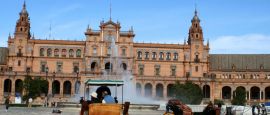Built in the 15th century on the foundations the Great Mosque, this gargantuan cathedral is Europe's largest gothic temple and third largest Christian church in the world. Browse the adjoining museum before heading into the impressive cathedral itself to marvel at the spectacular cloisters and stunning stained glass windows. Don’t forget to look out for the tomb of explorer Christopher Columbus who is buried here. La Giralda was the minaret of the former mosque and was once the highest tower in the world. Climb the tower’s 35 ramps to reach the top and admire the great views over Seville's rooftops and beyond.
Things to see in Seville
Tourist offices
Address: Plaza del Triunfo 1, Seville, 41004 Seville , Spain
Tel: +34 95 421 0005.
Opening Hours:
Mon-Fri 0900-1930, Sat-Sun 0930-1930.
www.turismosevilla.orgSeville's iconic yellow-and-white bullring is considered to be one of the most important bullfighting arenas in Spain. Dating from the 17th century, the historic arena spots a Baroque exterior and an impressive acoustic system within. The bullring houses an interesting museum that displays memorabilia and artefacts dating back to the 18th century. Exhibits include costumes, bull’s heads and paintings. Bullfighting remains controversial, though tourists can still catch a live bullfight during the bullfighting season, between Easter and October.
Seville's impressive Plaza de España was built for the Ibero-American Expo of 1929 and has since become an important symbol of the city. A sprawling square borders a crescent of Renaissance and neo-Moorish buildings, sitting around an extravagant monumental fountain. A moat flows under ornate staircases and gently past a succession of brightly tiled alcoves, one for each of Spain's provinces. Besides giving a crash course in Spanish history and geography, the square also provides a beautiful setting for a day of exploration in Seville.
Dating from the 14th century, the Reales Alcazares complex provides a perfect example of Moorish architecture and houses some of the finest mudéjar artistry and the most ornate gardens in Seville. Areas worth checking out are the sprawling gardens, Jardín de las Damas, and the Moorish Patio de las Doncellas. For those looking to explore the expensive complex at a leisurely pace, expect to take a few hours to cover the whole area.
Constructed in 1676 as a rest home for priests in the old quarter of Santa Cruz, this building is now used to promote culture in Seville. The interior patio is one of the prettiest in Andalusia, featuring beautiful uniform arched gates, a leafy garden and a pastel pink colonial exterior. For updates on cultural events in Seville, this is a place worth visiting.
Where better to learn all about Spain’s most traditional dance than in one of the main cities of its birth? Founded by world famous flamenco dancer Cristina Hoyos, who performed at the opening of the 1992 Barcelona Olympics, the museum takes visitors on a journey through the history and various styles of the dance. Excellently laid out with vibrant displays, it combines audiovisual installations with famous flamenco dresses, shoes and art. The museum also put on highly recommended flamenco shows each night.
Dating back to the 14th century, this atmospheric mansion combines ornate Moorish architecture with elegant Italian Renaissance styles. Informative audio guides lead visitors around the property, discovering the various rooms and serene sculpted gardens. The first floor and open courtyard are reminiscent of some of the opulent rooms in Granada’s Alhambra palace, while the upper floors and gardens are filled with Roman sculptures, trickling fountains and plush furnishings.
As a legacy of the Expo 92 trade fair, Isla Mágica is an amusement park themed around the golden days of Seville's illustrious seafaring trade. Located on the Isla de Cartuja, the theme park is best reached by car. For families with children, this is a perfect place to while away your weekend.
One of the most important art collections in Andalusia, the Seville Museum of Fine Arts features works from medieval times, through to the early 20th century, as well as paintings from the 17th century during the Golden Age of Sevillian art. Artists featured include Francisco de Herrera the younger, Murillo Zurbarán, and Valdés Leal.
Formerly a Moorish watchtower in the early 13th century, the Torre del Oro marked the edge of Seville's defences along the banks of the Guadalquivir River. Later the tower became a storage depot for gold and riches gathered on voyages to the Americas. Today, it is an emblematic landmark of the city and it houses a small naval museum that showcases Seville’s marine history.
Do you have any Feedback about this page?
© 2025 Columbus Travel Media Ltd. All rights reserved. No part of this site may be reproduced without our written permission, click here for information on Columbus Content Solutions.








 You know where
You know where